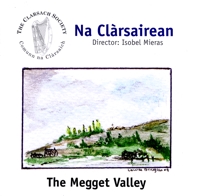The Megget Valley |
Buy this album now CD: £10.00+ p&p
|
| Profile page and discography |
Tracks
1. The Arran Boat
2. The Megget
Valley
3. Orkney Scenes
4. The Ballad of Thomas the Rhymer
5. The Isle
of May
6. The Falls
of Lora/Connel Bridge
7. Will ye no’ come back again?
The Music
1. The Arran Boat
A haunting slow air.
Soloist: Elinor Evans
2. The Megget Valley lies in the now beautiful and peaceful Scottish Border country. In 1529 however it was the scene of great violence when King James V, in his efforts to restore law and order among the many unruly cattle thieves or rievers, sent spies to watch the house of Perys Cockburn of Henderland. During the night, the king’s men attacked, burned down his house, hanged Perys and killed the entire household - only his wife Marjory escaped. Hundreds of years later in 1983 the peace was again shattered, this time by the excavation of the valley floor and construction of a dam to create a reservoir supplying water to the City of Edinburgh. All who lived there had their homes rebuilt on higher ground - only a few ruins were left under the water.
This story is told in the music, starting with
a gentle Introduction and Pastorale followed
by an improvised passage depicting the King’s spy and the subsequent
attack. The
Border Widow’s Lament tells how brokenhearted Marjory
carried her husband’s body away, dug his grave and buried him.
The Pastorale tune returns only to be followed by more
improvised music as the bulldozers and diggers build the Megget
Dam. Under the Water begins with gentle memories of life
in the drowned valley, eventually moving into a jig before the Pastorale
returns and peace is restore to the valley.
Reader: Gillean McDougall
Soloists: Calum Maclead and Sean Macphersan
3. Orkney Scenes
Standing Stones was inspired by the impressive prehistoric
stone circles, the Ring of Brodgar and the Standing Stones of Stenness - and
the television programme in which Billy Connolly danced naked among the stones!
The piece starts with a solo harp playing great chords, gradually giving
way to a single bass line which develops into a jig Iike dance as all
the harps join in before the great chords return finally fading into
silence.
Soloist: Calum Maclead
St Magnus was killed on the island of Egilsay in 1115 and buried there in unconsecrated ground. Later, at his mother’s request, permission was given for his remains to be removed and re-interred in Birsay. Finally when St Magnus Cathedral in Kirkwall, begun in 1137, was ready for consecration, the saint found his final resting place. The piece is in the style of a processional, imagining the carrying of Magnus from one resting place to another with due ceremony--and with the fine Orkney rain falling.
Harps at Hamnavoe pictures the small but busy port of Stromness which has been visited in turn by Vikings, whalers, explorers and tourists. It was written after visiting Mark Shiner’s harp workshop in Stromness.
4. The Ballad of Thomas the Rhymer
Some say that True Thomas played the harp. Certainly he was a musician
of great charm and popularity especially with the ladies. When he encountered
the Queen of Elfland he met his match as she compelled him to “harp
and carp” along with her. He remained in her service for seven
years before returning to his home under the “Eildon Tree.”
Reader: Gillean McDougall
Cello: Lucy Borthwick
5. The
Isle of May in
the Firth of Forth is completely silent during the winter months. In
Spring thousand of seabirds return to breed and, by June, the cries of
terns, kittiwakes, razorbills, puffins and others fill the air night
and day.
Soloists: Janette Bain, Meg Carroll and Sean Macpherson
6. The Falls of Lora is the name given to the tidal race which can often be seen at the mouth of Loch Etive underneath Connel Bridge near Oban.
7. Will ye no’ come back again? The
words of this Jacobite song were written by Lady Nairne. The tune is
traditional.
Reader: Gillean McDougall.
Soloist: Calum
Maclead
The Players
Clarsachs:
Janette Bain, Rita Bradd, Hazel Briton, Jenny Brockie, Main Brown, Meg
Carroll, Katie
Davidson, Catherine Dowell, Ellie Evans, Helen Forster, Stephanie Harrison, Holly
Hart, Sandra
Hollingdale, Anne Kelly, Annette Lambourne, Simon MacDonald, Cameron MacDonald,
Calum
Macleod, Sean Macpherson, Kiyoko Macpherson, Catriona Melville, Rena Mitchell,Amy
Moar, Katrina Mowat, Jane Palfery, Helen Quigley, Jennifer Rehfisch, Mary Scott,
Anne Spiers, Nancy Stewart, Jean Stock, Sheona Ure.
Plus:
Reader: Gilean McDougall, Flute: Clare Errington, Cello: Lucy Borthwick.
Special
thanks to:
Christine Macleod, Anne Moar and Neil Warden.
| Title: | The Megget Valley |
| Artists: | Na Clàrsairean The Orchestra of the Edinburgh Branch of the Clarsach Society Director Isolbel Mieras |
| Genre: | Trad / Contemporary |
| Format: | Audio CD |
| Our Ref: | A0536 |
| MCPS: | -- |
| Label: | -- |
| Year: | 2011 |
| Origin: | Scotland (UK) |
 The Megget Valley was commissioned by
the Clarsach Society’s Edinburgh Branch to commemorate
a special birthday for
The Megget Valley was commissioned by
the Clarsach Society’s Edinburgh Branch to commemorate
a special birthday for